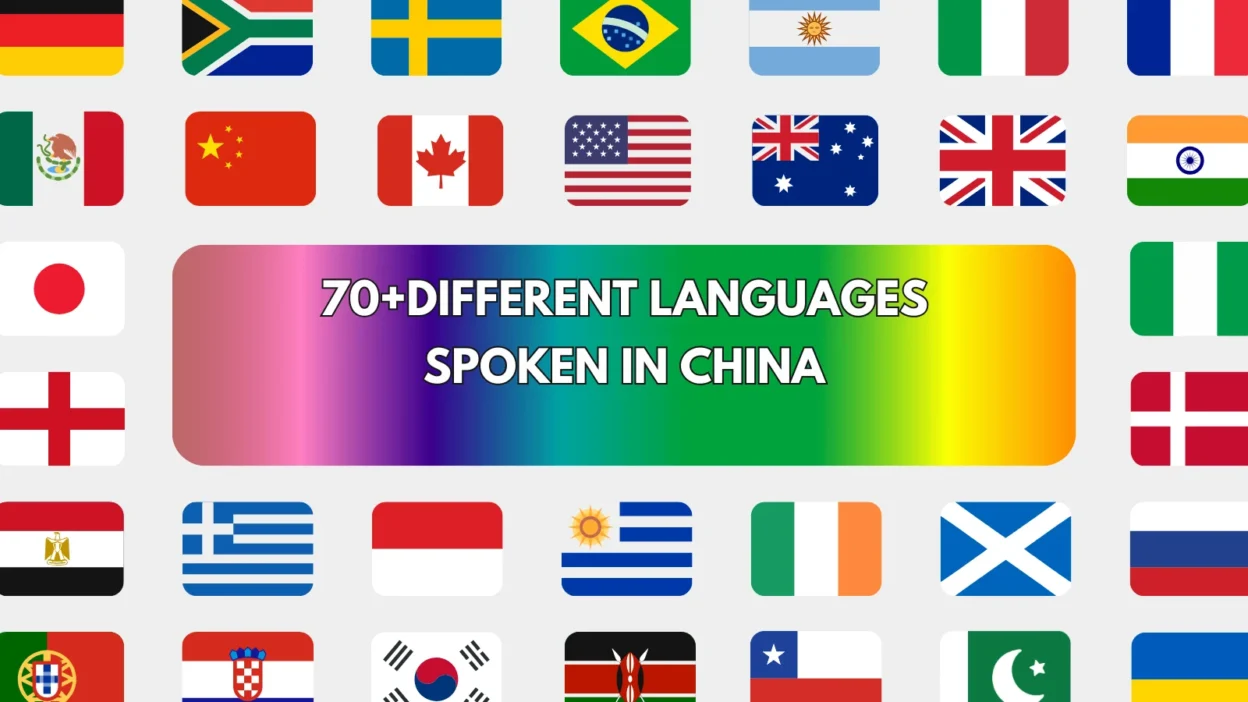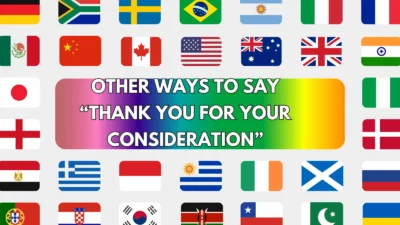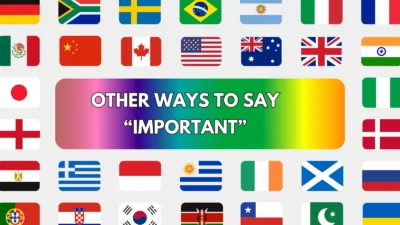China is one of the most linguistically diverse countries on Earth. While Mandarin Chinese (Putonghua/普通话) is the official and most widely spoken language, China is home to dozens of other Chinese dialects and over 55 minority languages. When people search for “different languages spoken in China”, they usually want to know what languages exist beyond Mandarin and where they are spoken.
This article gives you a clear list of 70 different languages in China, with their names, pronunciations, and example greetings.
70 Different Languages Spoken in China
- Mandarin Chinese (普通话 – Pǔtōnghuà) 🇨🇳 | Pronunciation: Poo-tong-hwa | Example: 你好 (Nǐ hǎo) – Hello
- Cantonese (粤语 – Yuèyǔ) 🇭🇰 | Pronunciation: Yue-yu | Example: 你好 (Néih hóu) – Hello
- Shanghainese (上海话 – Shànghǎihuà) 🇨🇳 | Pronunciation: Shang-hai-hwa | Example: 侬好 (Nong hō) – Hello
- Hokkien (闽南语 – Mǐnnányǔ) 🇨🇳 | Pronunciation: Min-nan-yu | Example: Li hó – Hello
- Hakka (客家话 – Kèjiāhuà) 🇨🇳 | Pronunciation: Ke-jia-hwa | Example: Ngì hó – Hello
- Gan Chinese (赣语 – Gànyǔ) 🇨🇳 | Pronunciation: Gan-yu | Example: 汝好 (Nū hó) – Hello
- Xiang Chinese (湘语 – Xiāngyǔ) 🇨🇳 | Pronunciation: Shyang-yu | Example: 侬好 (Nong hō) – Hello
- Jin Chinese (晋语 – Jìnyǔ) 🇨🇳 | Pronunciation: Jin-yu | Example: 你好 (Nǐ hǎo) – Hello
- Minbei Chinese (闽北语 – Mǐnběiyǔ) 🇨🇳 | Pronunciation: Min-bay-yu | Example: Li hó – Hello
- Pinghua (平话 – Pínghuà) 🇨🇳 | Pronunciation: Ping-hwa | Example: Néi hóu – Hello
- Tibetan (藏语 – Zàngyǔ) 🇨🇳 | Pronunciation: Dzang-yu | Example: Tashi Delek – Hello
- Uyghur (维吾尔语 – Wéiwú’ěryǔ) 🇨🇳 | Pronunciation: Wee-woo-er-yu | Example: Ässalamu eleykum – Hello
- Mongolian (蒙古语 – Ménggǔyǔ) 🇨🇳 | Pronunciation: Meng-gu-yu | Example: Sain baina uu – Hello
- Zhuang (壮语 – Zhuàngyǔ) 🇨🇳 | Pronunciation: Jwong-yu | Example: Ndaej mbouj – Hello
- Korean (朝鲜语 – Cháoxiǎnyǔ) 🇨🇳 | Pronunciation: Chao-sheen-yu | Example: 안녕하세요 (Annyeong haseyo) – Hello
- Kazakh (哈萨克语 – Hāsàkèyǔ) 🇨🇳 | Pronunciation: Ha-sa-ke-yu | Example: Сәлеметсіз бе? (Sälemetsiz be?) – Hello
- Manchu (满语 – Mǎnyǔ) 🇨🇳 | Pronunciation: Man-yu | Example: ᠨᠠᠮᠠᠨ (Naman) – Hello
- Yi (彝语 – Yíyǔ) 🇨🇳 | Pronunciation: Yee-yu | Example: Ngehh hxop – Hello
- Miao (苗语 – Miáoyǔ) 🇨🇳 | Pronunciation: Meow-yu | Example: Nyob zoo – Hello
- Dai (傣语 – Dǎiyǔ) 🇨🇳 | Pronunciation: Die-yu | Example: Sawasdee – Hello
- Lisu (傈僳语 – Lìsùyǔ) 🇨🇳 | Pronunciation: Lee-su-yu | Example: Ah nyi ma – Hello
- Naxi (纳西语 – Nàxīyǔ) 🇨🇳 | Pronunciation: Na-shee-yu | Example: A lu – Hello
- Qiang (羌语 – Qiāngyǔ) 🇨🇳 | Pronunciation: Chiang-yu | Example: Tɕiɑ⁵⁵ – Hello
- Dong (侗语 – Dòngyǔ) 🇨🇳 | Pronunciation: Dong-yu | Example: Laox ndraox – Hello
- Bouyei (布依语 – Bùyīyǔ) 🇨🇳 | Pronunciation: Boo-yee-yu | Example: Ndaej mbouj – Hello
- Hui (回族话 – Huízúhuà) 🇨🇳 | Pronunciation: Hway-zoo-hwa | Example: 你好 (Nǐ hǎo) – Hello
- She (畲语 – Shēyǔ) 🇨🇳 | Pronunciation: Sheh-yu | Example: Zaong di – Hello
- Tujia (土家语 – Tǔjiāyǔ) 🇨🇳 | Pronunciation: Too-jia-yu | Example: Ndraox da – Hello
- Bai (白语 – Báiyǔ) 🇨🇳 | Pronunciation: Bai-yu | Example: Hlai – Hello
- Wa (佤语 – Wǎyǔ) 🇨🇳 | Pronunciation: Wa-yu | Example: Lɔ³¹ – Hello
- Blang (布朗语 – Bùlǎngyǔ) 🇨🇳 | Pronunciation: Boo-lang-yu | Example: Ha la – Hello
- Achang (阿昌语 – Āchāngyǔ) 🇨🇳 | Pronunciation: Ah-chang-yu | Example: Ka lo – Hello
- Jingpo (景颇语 – Jǐngpōyǔ) 🇨🇳 | Pronunciation: Jing-po-yu | Example: Nga ai – Hello
- De’ang (德昂语 – Déángyǔ) 🇨🇳 | Pronunciation: De-ang-yu | Example: Ta le – Hello
- Lahu (拉祜语 – Lāhùyǔ) 🇨🇳 | Pronunciation: La-hoo-yu | Example: Hee deh – Hello
- Oroqen (鄂伦春语 – Èlúnchūnyǔ) 🇨🇳 | Pronunciation: O-ro-chen-yu | Example: Naga – Hello
- Evenki (鄂温克语 – Èwēnkèyǔ) 🇨🇳 | Pronunciation: Eh-wen-kee-yu | Example: Bayan – Hello
- Daur (达斡尔语 – Dáwòěryǔ) 🇨🇳 | Pronunciation: Da-wo-er-yu | Example: Sain baina uu – Hello
- Hezhen (赫哲语 – Hèzhéyǔ) 🇨🇳 | Pronunciation: He-jen-yu | Example: Laha – Hello
- Salar (撒拉语 – Sālāyǔ) 🇨🇳 | Pronunciation: Sa-la-yu | Example: Salam – Hello
- Bonan (保安语 – Bǎoānyǔ) 🇨🇳 | Pronunciation: Bo-an-yu | Example: Salam – Hello
- Dongxiang (东乡语 – Dōngxiāngyǔ) 🇨🇳 | Pronunciation: Dong-shyang-yu | Example: Salam – Hello
- Yugur (裕固语 – Yùgùyǔ) 🇨🇳 | Pronunciation: Yu-goo-yu | Example: Sain uu – Hello
- Tatar (塔塔尔语 – Tǎtǎěryǔ) 🇨🇳 | Pronunciation: Ta-ta-er-yu | Example: Sälam – Hello
- Kirgiz (柯尔克孜语 – Kēěrkèzīyǔ) 🇨🇳 | Pronunciation: Kir-giz-yu | Example: Salamatsyzby – Hello
- Xibe (锡伯语 – Xíbóyǔ) 🇨🇳 | Pronunciation: She-bo-yu | Example: Naman – Hello
- Jino (基诺语 – Jīnuòyǔ) 🇨🇳 | Pronunciation: Jee-no-yu | Example: A lo – Hello
- Maonan (毛南语 – Máonányǔ) 🇨🇳 | Pronunciation: Mao-nan-yu | Example: Laox ndraox – Hello
- Pumi (普米语 – Pǔmǐyǔ) 🇨🇳 | Pronunciation: Poo-mee-yu | Example: Ah lo – Hello
- Derung (独龙语 – Dúlóngyǔ) 🇨🇳 | Pronunciation: Doo-long-yu | Example: Na ma – Hello
- Nu (怒语 – Nùyǔ) 🇨🇳 | Pronunciation: Noo-yu | Example: A le – Hello
- Gaoshan (高山族语 – Gāoshānzúyǔ) 🇨🇳 | Pronunciation: Gao-shan-yu | Example: Li ho – Hello
- Gelao (仡佬语 – Gēlǎoyǔ) 🇨🇳 | Pronunciation: Ge-lao-yu | Example: La ndraox – Hello
- Monba (门巴语 – Ménbāyǔ) 🇨🇳 | Pronunciation: Mon-ba-yu | Example: Kham – Hello
- Lhoba (珞巴语 – Luòbāyǔ) 🇨🇳 | Pronunciation: Lo-ba-yu | Example: Nagi – Hello
- Yao (瑶语 – Yáoyǔ) 🇨🇳 | Pronunciation: Yao-yu | Example: La ndraox – Hello
- Waic (佤语支 – Wǎyǔzhī) 🇨🇳 | Pronunciation: Wa-ic-yu | Example: Lo – Hello
- Kam (侗语支 – Dòngyǔzhī) 🇨🇳 | Pronunciation: Kam-yu | Example: Djao – Hello
- Hlai (黎语 – Líyǔ) 🇨🇳 | Pronunciation: Lie-yu | Example: Ba ha – Hello
- Achinese (阿昌语 – Āchāngyǔ) 🇨🇳 | Pronunciation: Ah-cheen-yu | Example: Halo – Hello
- Jiarong (嘉绒语 – Jiāróngyǔ) 🇨🇳 | Pronunciation: Jia-rong-yu | Example: Tso – Hello
- Khams Tibetan (康巴藏语 – Kāngbāzàngyǔ) 🇨🇳 | Pronunciation: Khams | Example: Tashi Delek – Hello
- Amdo Tibetan (安多藏语 – Ānduōzàngyǔ) 🇨🇳 | Pronunciation: Am-do | Example: Tashi Delek – Hello
- Shigatse Tibetan (日喀则藏语 – Rìkāzé Zàngyǔ) 🇨🇳 | Pronunciation: Shi-ga-tse | Example: Tashi Delek – Hello
- Ladakhi (拉达克语 – Lādákèyǔ) 🇨🇳 | Pronunciation: La-da-kee | Example: Jullay – Hello
- Oirat (卫拉特语 – Wèilātèyǔ) 🇨🇳 | Pronunciation: Oi-rat | Example: Sain baina uu – Hello
- Chahar Mongolian (察哈尔蒙古语 – Cháhāěr Ménggǔyǔ) 🇨🇳 | Pronunciation: Cha-har Mongol-yu | Example: Sain uu – Hello
- Buryat (布里亚特语 – Bùlǐyàtèyǔ) 🇨🇳 | Pronunciation: Bu-ree-at-yu | Example: Sain baina uu – Hello
- Dongxiang Monguor (土族语 – Tǔzúyǔ) 🇨🇳 | Pronunciation: Dong-xiang-yu | Example: Salam – Hello
- Even (鄂温语 – Èwēnyǔ) 🇨🇳 | Pronunciation: Eh-wen-yu | Example: Bayan – Hello
Conclusion
China is not just a nation of one language but a mosaic of 70+ languages that reflect its deep cultural and ethnic diversity. From the dominance of Mandarin to the musical tones of Cantonese, the elegance of Shanghainese, and the unique traditions of Tibetan, Uyghur, Mongolian, and Zhuang, each language holds its own history and charm.
These voices tell the story of the people who have shaped China’s identity for thousands of years. Understanding them opens doors to richer cultural appreciation, deeper connections, and respect for the many ethnic groups that make up this vast country. No matter where you travel in China, every word you hear is part of a larger story that celebrates unity in diversity.




